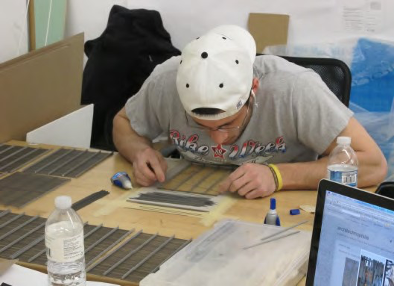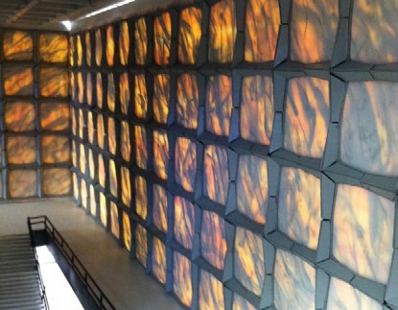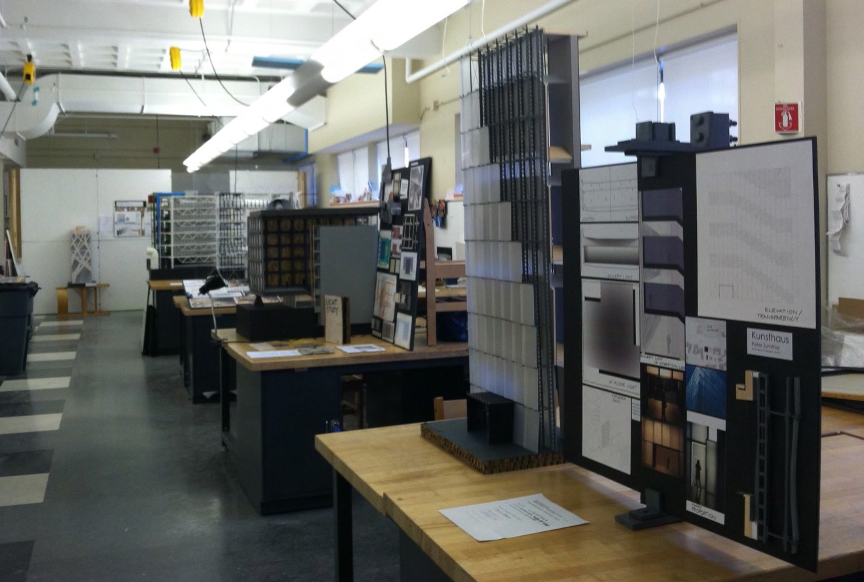Ingrid Strong
Wentworth Institute of Technology, Boston, MA strongi@wit.edu
“…the only way to know things – that is, from the very inside of one’s being – is through a process of self discovery. To know things, you have to grow into them, and let them grow into you, so that they become a part of who you are…The mere provision of information holds no guarantee of knowledge, let alone understanding. Things, as proverbial wisdom has it, are easier said than done.”[1]
–Tim Ingold
Summary statement
Heuristic teaching pedagogy in architectural education is commonplace in many universities. From drawing and model making by hand to digital representation and fabrication, one can argue that, in order to understand the path from imagined design to the real artifact, embodied learning is a valuable process. To dig a little deeper as to why that is so, I argue that it involves engaging the emotional, haptic and intuitive connections through processes of making. Juhani Pallasmaa states, “Architecture is an art form of the eye, the hand, the head and the heart.”[2] In other words, touch connects: our work to our intentions, our intentions to our world. In a sense, we inhabit what we make as we make it. It also implies a process that, not unlike a spiritual journey, is a dual yet integrative web of the learned and the deeply felt. What the implications are for teaching and learning the art and craft of architectural design is the topic of this abstract. As Ingold reminds us, things are easier said than done.
Topic
How do we interpret making through the lens of ‘learning to learn’, and how is it fruitful? Craft, according to Richard Sennett, is based on process in pursuit of mastery. To learn both the art and craft of architectural design through making is the beginning of that process. The “process of self discovery” (Ingold) through making can be profound and has its moments of revelation. From absorber/observer, to maker using material, light, shadow, structure, the student attempting to understand and create that spatial moment gets closer to a ‘mastery’ and self discovery. Craft as process and realization has powerful implications. Richard Sennett’s analysis of improvisation and intuition, tool use and craft brings us to surprise, then ‘poesis’ in the classical sense:
“Surprise is a way of telling yourself that something you know can be other than you assumed. Many technology transfers that were meant to be merely rote applications of one procedure to another become illuminating just in this stage; there was something fuller or more manifold in the initial procedure than had been assumed. It’s at this point that the maker begins to experience wonder. Ancient Greek embedded wonder in poiein, the root word for making. In the Symposium Plato says, ‘Whatever passes from not being to being is a poesis’, a cause for wonder. Walter Benjamin uses another Greek word, aura – ‘bathed in its own light’ – to describe the wonder that a thing exists.”[3]
Scope
By extension, is it possible that this goes so far to say that there is a spiritual component in learning through making? If Sennett is correct, and the surprise in discovering the made is embedded with ‘wonder’, then it seems plausible. Whether students feel these phenomena is at this point unknown, but if, in fact, making, prayer and meditation are bound by a common theme – that one becomes open to possibility – then it seems plausible that making impacts the student’s experiences through an openness or willingness to learn. It may be related to ‘creative flow’, or might be a deeper sense related to awareness and purpose.
In his book, Architecture and Embodiment, Mallgrave quotes from Ellen Disanayake, Walter Freeman, and Charles Pickstone’s writings as a way to conjoin the multivalent threads of knowing:
“Even the visual arts cannot be isolated unto themselves, because they, in fact ‘draw forth cross-modal sensations of tactility and and kinesis with their emotional associations from color, form, and texture’ – as the abstract arts of the twentieth century have made apparent.’ Again, group dances with their rhythmic clapping and movements are not just animated artistic expressions of tribal unity, because they, as Walter Freeman has suggested, also ‘release brain chemicals that promote affiliative emotions and brain states conducive to accepting and incorporating collective values.’ It is in this sense that Dissanayake, in drawing upon Charles Pickstone, can point out that art, like its kindred behaviors of sexuality, love and religion, may also ‘be revelatory – a means of selftranscendence that can disclose the sacred in the familiar and the ordinary.”[4]
Here, mind and meaning are intricately connected, our bodies inextricably linked to our minds, one ‘learning’ from the other in an ever expanding knowledge cycle.
Case Study
Learning how to create is also a wonder, and informs the student experience. The Institute’s architecture department where I teach commits to its mission statement, “The Art of Making” in many ways. From design/build to façade analysis and construction to explorations in craft, material and fabrication, the department supports the heuristic pedagogy in most, if not all, architecture courses. In observing other professors that emphasize ‘making’, the made pieces reveal the surprises, flaws and wonder in making. For many students, the iteration and repetition of ‘Improvisational mastery’ provides immediate feedback, informing the next slice on a wood plank or the next panel of plexiglass. Between repetitive making and anticipation of seeing the made (Sennett), the student learns the reward of making for its own sake. The below is one example of embodied learning.
Over a one-week period, in groups of three, students analyze, then build, their chosen precedent. This is a project that combines the sophomores’ Materials and Methods course with the design studio so that the materials and methods lectures can be applied and translated to design intent. While the connection may be unclear at first, discovering the mysteries of how the precedent works — in detail -– brings them closer to knowing what the precedent is, not simply as it appears in two-dimensional representations or photographs.
Student teams work together to systematize methods of construction: they examine composition, proportion and detail, experiment with a material’s properties, and sleuth further to answer the as yet unknown. They build thick walls, roofs and floors, figure out how various types of skins work, how materials connect, how light comes in and what can be seen.
Each finished model is characteristic of the six hands that crafted it through repeated, ever evolving gestures of making. “The hand…is an instrument of world forming. It is a hand precisely because it is not tied to any particular way of working, but delivers an engagement that is both thoughtful and reflexive, guided by consideration.”[5] This world forming is existential by its very nature, and can have a profound effect on the student as he or she realizes its implications. While it is an intense assignment, it’s the students’ desire to “do well for its own sake” (Sennett) that gives meaning to the work.


Making MIT’s Media Lab screens, 2012 Crafting the Harry Parker Boathouse façade, 2012
The made figures are visual and tactile evidence of a collective effort in a quest to unravel a mysterious spatial and material beauty. The detailed models are large enough for observers to experience the phenomenon of a space, absorbable by virtue of its scale. As Richard Sennett states, “The craftsman represents the special human condition of being engaged”,[6] is to then imagine how, in this case, the student, through that engagement, can learn and imagine, using emergent skills of seeing and making.

Beinecke Rare Books Library, 2013

Gallery-style exhibit of completed analyses and models, 2013
Intended Conclusions
To posit an absolute response to the question of spirituality and heuristic pedagogy in architectural education would be reductive and presumptuous. I do believe, however, that we cannot simply dismiss the possibility that, between the ritual and repeated acts of making to mastery, there is a profound experience occurring ‘in the ordinary’. I argue that making (or learning to make), like a spiritual journey, shares common characteristics: process, repetition, ritual, revelation, wonder. Light, dark, material, space are ineffable elements that draw us to a work of architecture. Subsequently, knowing how to harness light in all its symbolic, phenomenal beauty offers a student the tools to craft a particular experience. Going beyond the rationality of architecture into the emotional and memorable[7] is acknowledging architecture’s multivalent functions. Moments of realization, of wonder, ties to making, and can then emerge, formed, if imperfectly. Making and learning to make is perhaps an invitation to a deeper sense of purpose. Craft is a mystery revealing its secrets, beyond the cerebral and practical, into purpose and wonder.
References
Tim Ingold, Making: Anthropology, Archeology, Art and Architecture, (Routledge Press, London and New York, 2013)
Harry Francis Mallgrave, Architecture and Embodiment: The Implications of the New Sciences and Humanities for Design, (Routledge Press, London and New York, 2013 Pp 86-87)
Juhani Pallasmaa, The Thinking Hand: Existential and Embodied Wisdom in Architecture (Wiley and Sons, LTD, 2009)
Tim Ingold, Being Alive: Essays on Movement, Knowledge and Description (Routledge Press, London and New York, 2011) Richard Sennett, The Craftsman (Yale University Press, 2008)
[1] Ingold, Making, p. 1
[2] Pallasmaa, The Thinking Hand, 147
[3] Sennett, The Craftsman, 211
[4] Mallgrave, Architecture and Embodiment, 197
[5] Ingold, Being Alive, 82.
[6] Sennett, The Craftsman, 20
[7] Pallasamaa, mind in arch, p. 57



